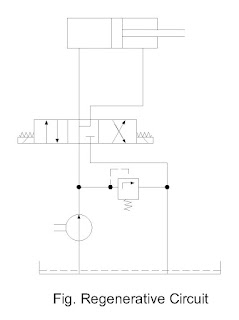In a typical hydraulic cylinder, the cylinder has a larger extending force than a retracting force. This is because of the difference in the area of the bore side and the annulus side of the piston. Hence, the hydraulic regenerative circuit can be used to equalize the force.
Table of Contents
What is a Regenerative Circuit?
A circuit is said to be operating on the regenerative principle when the fluid returning from another end of the cylinder is forced into the head end of the cylinder.

Obviously, some energy is consumed to force out the fluid from the piston rod end when the cylinder is extending. The regenerative circuit enables to utilize this part of the energy, which would have otherwise been wasted. The net result of regeneration is increased in the cylinder speed, with the same discharge pump.
Construction and Working of Regenerative Circuit
The circuit in fig. depicts a typical regenerative circuit with a solenoid operated 4/3 direction control valve.
 |
| Regenerative Circuit Diagram |
The regenerative circuit is similar to the linear circuit except, the change in the center position of the direction control valve.
When the valve is in the central position the cylinder extends, at about twice the normal speed, thus affecting the regenerative function.
When the valve shifts to left, the cylinder retracts. The regenerative principle can be applied to any motion i.e. extending motion or retracting motion.
See Also:





Thank you for a wonderful article. It helped me a lot.